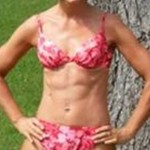Great abs are made in the kitchen! So if we want this six pack let’s clean up our diet a little shall we? Oh and yup that is me a few years back… with a lot of work and the absolute cleanest I’ve ever eaten…. 😉
Ok – so I understand that this week’s mini challenge may not be the most exciting, but it really is important to understand what types of foods we are consuming, especially for those of you who say “I’m really not eating that bad, and can’t understand why I’m not losing weight” Ugh, that was so me! Part of the issue may be portion control which we talked about last week, the second part may be the types of food you are eating. So this week’s mini challenge is to be aware of what types of foods you are putting in your body.
Below are just some of the basics:
Protein – protein should be eaten with every meal and snack and here’s why. Because the body doesn’t like to let go of fat, if we don’t eat enough protein it will take it from our muscles. The goal while “dieting” is to lose fat not muscle. Protein will help prevent muscle loss as well as stabilize our blood sugar and appetite.
- Good proteins include – lean meats, poultry (chicken and turnkey avoid dark meat), fish, dairy product (choose low-fat or skim), Eggs, Nuts and seeds.
- Serving size: 3 – 4 oz – should look like a deck of cards or the size of the palm of your hands.
Carbs – All carbs are not evil! There are good and bad carbs. Simple carbs absorb quickly and spike the blood sugar, and your appetite. These include foods like white rice, white bread, and white flour. You want carbs that are complex and take longer to absorb into your blood stream this keeps the blood sugar level which helps keep your appetite in check. Complex carbs are foods like sweet potato, quinoa, brown rice, and whole grain breads.
Fiber – fibrous foods help to keep you full longer on fewer calories, this stuff is gold! Some great sources of fibrous foods are whole wheat or unprocessed grain, carrots, celery, green or kidney beans, brown rice, raw or dried fruits, oat or wheat bran, whole oats or oatmeal. So again with fibrous foods you can eat more, stay fuller longer and consume fewer calories. This one is definitely a win-win in my book!
Alcohol – Ugh! Hate to burst your bubble, but the truth about alcohol it is this… Right off the bat – alcohol is absorbed directly into the blood from the stomach and the small intestine. The liver is responsible for metabolizing this, but is also responsible for metabolizing fat. When you drink the liver stops processing fat to deal with alcohol, which it sees as a toxin to the body. So now whatever you have been eating is more likely to be stored as fat. Oh boy!
Some suggestions to help:
- Drink 1 glass of water per drink helps to metabolize it
- Space them out – it takes the liver 1 hour to process 1 oz of alcohol
- Consider it a carb if you’re going to drink, cut back or eliminate the carbs with your meal.
Fats – ARE good for us and are necessary for brain and nerve activity, healthy cell membranes, blood vessels and more. Here is the low down on fats!.
- Omega-3 and Omega-6 fatty acids cannot be produced by the body and must be obtained through diet.
- Good sources of Omega-3 fatty acids include:
- flaxseeds & flaxseed oil, fatty fish, soybeans, walnuts and some dark leafy greens, such as kale and spinach.
- The richest sources, however, are from the flaxseeds, flaxseed oil, and fatty fish – like Salmon.
- Good sources of Omega-3 fatty acids include:
- Saturated fats are solid at room temp and are fats from animal products. Saturated fats directly raise LDL (bad) cholesterol levels
- Unsaturated fat stay liquid and are primarily from plant and fish.
- There are two types of unsaturated fatty acids – both have been shown to reduce LDL (bad) cholesterol and maintain HDL (good) cholesterol
- Monounsaturated – This type of fat is preferable to other types of fat and can be found in olive oil, nuts, peanut oil, canola oil and avocados.
- Polyunsaturated – These are found in safflower, sesame, corn, cottonseed and soybean oils.
- There are two types of unsaturated fatty acids – both have been shown to reduce LDL (bad) cholesterol and maintain HDL (good) cholesterol
- Trans-fats are the worst! This is unsaturated fat from vegetable oil that has been made saturated fat in the lab, which is called hydrogenation and increases the shelf life of products! Things like donuts, chips, imitation cheese, cookies, crackers, deep-fried food. This stuff should be avoided at all costs!
- Fat serving size: Fats should be eaten sparingly. For example: a tablespoon of oil, a quarter avocados, or a pat of butter.
If you can, try to look at food as fuel for your body – we need it just like we need the air to live. If we don’t eat enough our systems can shut down and we can die. If we eat too much, we risk developing heart disease which is the leading cause of death in morbidly obese people. The goal is to find balance, to be healthy, to be aware of what types of food we are putting in our body and the affect those foods have on our body.
Interesting stuff right?
Thanks again for stopping by!
LeeAnne




No comments yet.